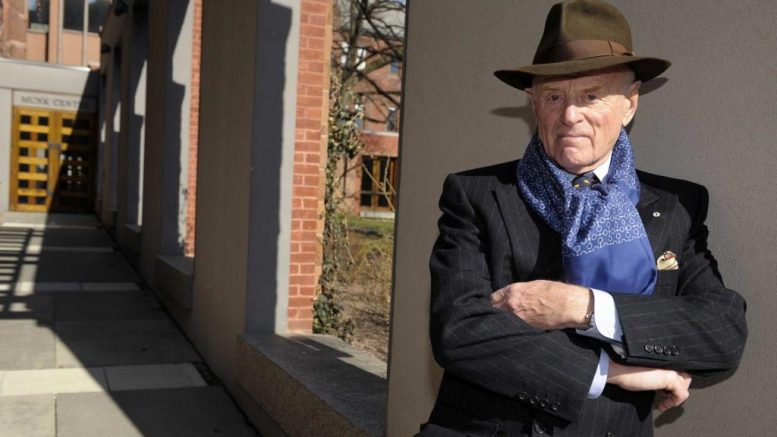While prices for the major metals and other mined commodities mostly went sideways during 2018, there was plenty of big news over the year — much of its stoked by political pressures on miners. Here are our picks of the top mining stories of 2018.
8. Beta Hunt bonanza — In the feel-good story of the year, RNC Minerals in September announced it had found a 95-kilogram specimen of rock at its Beta Hunt mine in Australia containing 2,400 oz. gold worth an estimated $4 million, and another 65-kilogram specimen with an estimated 1,600 oz. gold valued at $2.6 million.
A cash-strapped RNC had been a day away from selling the property and refocusing on its Canadian assets when president and CEO Mark Selby received an email from his team on the ground telling him they had hit gold in a big way. RNC’s fortunes have since turned around, as recent production from Beta Hunt continues to smash forecasts.
7. Death of Peter Munk — Passing away on March 28, 2018, Peter Munk transformed Barrick Gold over several decades from a small producer into the world’s biggest gold producer in gold output and market value. Munk repeatedly took daring initiatives in building up Barrick: using unorthodox financing such as hedging; bringing in autoclaves to mine refractory ore in Nevada; launching bids — friendly or otherwise — for equal-sized or even larger rivals; entering countries emerging from internal conflict; bidding for early-stage exploration plays, such as Arequipa Resources; and fully committing to large but risky exploration programs.
6. McArthur River suspension — You know the uranium market is bad when the top uranium miner indefinitely suspends the world’s best uranium mine. In July, Cameco shuttered its McArthur River and Key Lake uranium assets in Saskatchewan, laid off 550 site employees and shrunk its head office count by 150 positions.
Cameco had initially suspended operations at the two sites in January, laying off some employees at the time, and had once planned to reopen the sites after 10 months.
5. Notable deals — It was busy year of M&A for mid-tier miners and advanced explorers, including: Zijin winning a biding war for Nevsun; South32 buying Arizona Mining; Pan American scooping up a troubled Tahoe; Hecla picking up Klondex; and a flurry of eight- and nine-figure streaming deals.
4. Rusal sanctions — The global aluminum markets were thrown into an uproar on April 6 when the U.S. government imposed tough sanctions on Russia’s oligarchs, with aluminum giant Rusal and its parent company En+ Group getting caught in the net, due to their control by oligarch Oleg Deripaska.
Aluminum prices soared more than 20% to US$2,500 per tonne after the sanctions imposition, stoking the biggest five-day gain in 30 years.
3. DRC disruptions — The Democratic Republic of the Congo kept popping up in mining stories throughout the year: investigations into the murky activities of Dan Gertler in the country; substantial hikes in mining taxes; international concern over artisanal cobalt mining; and Glencore’s financial, legal and operational problems in the country.
2. The arrival of lab-grown diamonds — Long the subject of speculation as to their retail viability, laboratory-grown diamonds went mainstream in mid-2018, with De Beers Group launching a company named “Lightbox Jewelry” that will exclusively produce and sell laboratory-grown diamond jewellery on the Internet, using technology developed by De Beers subsidiary Element Six.
De Beers will spend US$94 million over the next four years to boost the Lightbox brand and build a Element Six production facility near Portland, Ore., adding to Element Six’s existing facilities in the United Kingdom. Once fully operational, the Portland plant could produce upwards of 500,000 rough carats of lab-grown diamonds per year for the retail market.
1. Barrick-Randgold merger — It’s easy to pick the top story of 2018: Barrick Gold’s surprise, all-share merger with Africa-focused gold miner Randgold Resources, which will create the world’s largest gold miner by all common metrics when the deal closes on Jan. 1, 2019.
When the no-premium merger was announced on Sept. 25, the added geopolitical risk of Randgold’s much heavier weighting towards Africa was more than offset for investors by news that Randgold head Mark Bristow and his team would stay on, with the promise of remaking Barrick into a leaner, more profitable miner in Randgold’s image.
At the end of 2017, Barrick had 64.4 million oz. gold in reserves. The company is guiding 2018 production of 4.5 to 5 million oz. gold.
The new Barrick could produce upwards of 6 million oz. gold in 2019 from Barrick and Randgold’s current mines — regaining the crown as the world’s largest gold miner from Newmont Mining.


Be the first to comment on "Top stories of 2018"